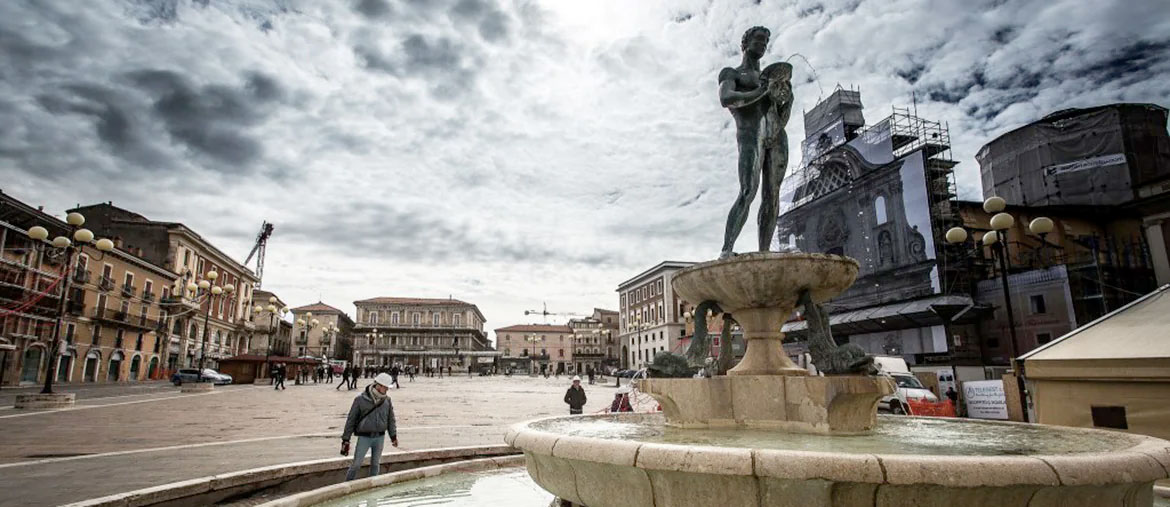
City of just under 70 thousand inhabitants , L’Aquila is the capital of the Abruzzo region. Founded in 1254, until the 1930s it was called Aquila degli Abruzzi. The urban center is located at the foot of the Gran Sasso, along the Aterno river. The seismic sensitivity of the area is known: L’Aquila was the victim of earthquakes in 1315, 1461, 1703 and 2009.
It deserves to be visited, however, for its remarkable artistic and historical heritage, with the walls of medieval origin, the many Renaissance style churches and the neoclassical and baroque buildings resulting from the reconstructions carried out after the earthquake of the eighteenth century.
How to get to L’Aquila
To get to L’Aquila it is possible to take the buses of the Autolinee Tua departing from the Tiburtina station in Rome or from Pescara; between the capital and L’Aquila the travel time is about three and a quarter hours. From Pescara, however, it is necessary to go to Piazza della Repubblica to reach the bus station next to the Central Train Station.
For those arriving by plane, reference can also be made to Abruzzo International Airport , with buses departing every ten minutes. Finally, by car, it is necessary to take the A24 and exit at L’Aquila, or the A25 and exit at Bussi, and then take the State Road to L’Aquila.
The cuisine of L’Aquila
L’Aquila is a purely mountain cuisine, with original ingredients: just think of the typical appetizer of the city, that is the Aquilana sauce, which is prepared with ox marrow, butter, cooking cream, eggs and Abruzzo saffron. Among the first courses, spaghetti alla chitarra and fregnacce with tomato-based sauce and lamb meat are widespread. The pecorara rings, on the other hand, are accompanied by sauce and sheep ricotta. The production of nougat is another strong point of the local gastronomic tradition, while gentian and nocino are ideal to accompany the ferratelle, with a diamond pattern in relief. As in the rest of Abruzzo, kebabs are prepared, but sheep alla cottora is especially typical.
Traditions of L’Aquila
One of the most anticipated events in the city is the Celestinian Forgiveness, which takes place every year on 28 and 29 August. The mayor of L’Aquila reads the Bull of Forgiveness issued in September 1294 by Pope Celestine V, while a cardinal who arrived at the invitation of the archdiocese opens the holy door of the basilica of Collemaggio.
On June 10, however, is the patronal feast of San Massimo , but the feast of Sant’Agnese and delle Malelingue are also celebrated on 21 January and the feast of San Bernardino between 19 and 21 May.
Natural areas in the city
The Tratturo Magno, also known as the Tratturo L’Aquila – Foggia, is known for being the largest tratturo in our country among those used by transhumant shepherds who went to the Foggia fair. Of course, the areas of the Gran Sasso and Monti della Lega National Park , as well as the Regional Natural Reserve Sorgenti del Fiume Vera, in the hamlet of Tempera, deserves a tour, which allows you to go up the entire watercourse and reach, in fact, up to the sources. Mountain lovers can reach the Fontari Refuge in Campo Imperatore or the Duca degli Abruzzi Refuge on Monte Portella, at more than 2,300 meters above sea level.
The most important parks in the city are those of the Castle, around the Strong Spanish , and of the Sun, near the basilica of Collemaggio. Finally, in the warmer months there is nothing more relaxing than finding a little shade in the pine forests of Pesco Croce and Colle Cerasitto, in the Pineta di Roio in Monteluco, in the Pineta di Arischia along the hairpin bends of the Capannelle Pass or in the Pine forest of San Giuliano above the convent of the same name.
The monuments to see in L’Aquila
There are more than 60 active churches in the historic center of L’Aquila, and the three basilicas are the most important: the basilica of San Giuseppe Artigiano , that of Collemaggio and that of San Bernardino. An ideal city tour, however, must also include the Church of San Domenico, the Cathedral of Santi Massimo and Giorgio and the Church of San Pietro a Coppito. Moving to the hamlets, then, the district of San Giuliano hosts the convent of the same name, while in Paganica there is the sanctuary of the Madonna d’Appari and in Bazzano the Church of Santa Giusta fuori le mura does not go unnoticed.
As for the civil architecture, however, the presidency of the Region is hosted by Palazzo Centi, while the regional council is located at Palace of the Exposition and the town hall is located in Palazzo Margherita. In via Simeonibus you can see the so-called Cancelle, ogival arches dating back to the fifteenth century. In Borgo Rivera, then, the fountain of 99 spouts deserves a stop, and in Piazza Margherita there is the Fountain of Neptune.


